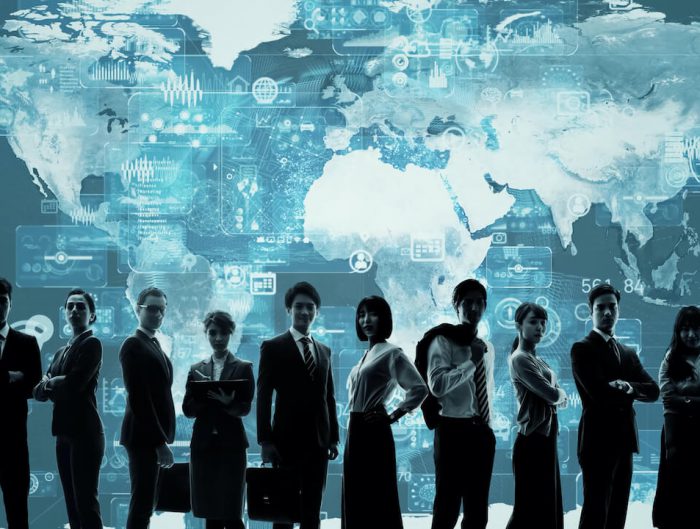Get comfortable in a “Phygital” work environment, or be left behind, says HR leader, Gerard Koh.

While some yearn to return to the office, the reality is that working remotely could become a permanent practice.
Is remote work here to stay? Earlier this year, Covid-19 forced us to change the way we work. Since then, many leaders and employees, even those who resisted it in the past, have realised the benefits of working remotely. Considering this and the possibility of another pandemic emerging in the near future, some businesses say they might make remote work the norm.
In a recent opinion piece, Gerard Koh, Head of Human Resources at NCS, a leading information, communications and technology service provider, suggested a “Phygital” world instead. This is where online and face-to-face interactions complement rather than substitute each other. But what will it take for leaders and employees to become comfortable with this and sustain it beyond the current crisis?
In an e-mail interview with PeopleSearch, Koh expounded his views. Addressing the questions in a personal capacity, he said those who don’t shift their paradigms about the future of work “might find themselves being left behind as their competitors move into more agile ways of work.”

Head of Human Resources, NCS, Gerard Koh.
Q: You’ve said that post-Covid, it’s not useful to set HR policies around the dichotomy of on-site working versus WFH. Explain your reasons for saying this.
Decisions on where people work must be driven by effectiveness and empowered by a culture of trust. Where one works is just a means to an end. To that end, in the future, organisations that empower their teams to be nimble, agile, and collaborative are the ones that will see energised teams that can better navigate a business environment that is volatile, ambiguous and ever-changing. Therefore, it is more useful to think of how to allow these teams to be agile, rather than where they ought to be.
Q: You said that business and HR leaders should instead be asking, “Where should my people be located to be most effective, and can I empower them and their team leaders to make the decision themselves?” You explained that this “requires a significant cultural shift anchored on the elements of trust and empowerment.” How can organisations begin to effect this cultural shift?
Trust has to be anchored first on building a common purpose and direction, and engaging our people in the “Phygital” World, allowing the dispersed and remote workforce to march in the same direction. To strengthen the social fabric of the organisation, leaders must engage employees in new ways that marry the strengths of a hybrid digital-physical or “Phygital” world, where online and face-to-face interactions complement rather than substitute each other. While face-to-face interactions may decline, online communication and sync-up meetings should increase to make up for the loss of informal face-to-face interactions at the workplace. Leaders must regularly communicate directions (the “Whys” and “Whats”), encourage dialogue and sharing, and empower their remote teams to develop actions plans to do their jobs (the “Hows”).
Building on that, we have to shift from an output to outcome-based culture.
Before Covid-19, companies used rules and supervision to govern behaviour and control their teams. Employee activity was monitored and performance was measured based on output such as the number of hours spent at the workplace, number of new initiatives worked on, dress codes, etc. Today, organisations should evaluate outcomes instead. They should measure the desired effects such as customer satisfaction scores and cost reductions, rather than the effort and time put into work.
Lastly, for leaders to trust their team can deliver on their tasks and vice versa, there has to be a reshaping of the skills needed to operate in the “Phygital” world that in some ways, has less structure and rhythm than a traditional work-from-office regime. Leaders and staff need to be trained to operate effectively in more flexible and agile ways in this new world.
Q: Experts have long encouraged organisations to set outcome-based goals rather than output-based ones. However, many organisations have yet to become adept at this. What do you think held them back in the pre-Covid era?
There are two reasons. Firstly, it is not easy to set targets for outcomes as some may not be easily measurable in numbers. At best, proxy measurements would have to be used for some outcomes. Secondly, managers like to measure output as it is a way for them to monitor and control the process of reaching the outcomes; or at least they think and hope so. I think both types of KPIs are necessary. However, the output-based KPIs have to be selected carefully so that they don’t merely measure the effort, but also how these can ultimately lead to the desired outcomes. For example, how does the number of hours one spends in the office churning out reports (output) relate to sales and revenue (outcome)?
Q: However, if leaders only change their approach because they’ve been forced to by circumstances, there’s a danger they’ll go back to their old ways once the crisis is over. What do you think will be needed to sustain change?
The best reinforcement of this approach would be observable improvements in organisational effectiveness. If this way of work results in better business performance, higher employee engagement and retention, and customer satisfaction, why wouldn’t leaders use this approach? I believe most successful leaders are pragmatic and do what works best for their people and organisation. Therefore, they each have to calibrate the degree of physical versus digital work that is best suited for their organisation.
Q: How can leaders who themselves are not yet open to the idea of working with a dispersed workforce, effect a personal paradigm shift that will enable them to authentically create a sense of common purpose and direction for their teams?
I think leaders have little choice but to force themselves to make this paradigm shift and to do it fast. Covid-19 has merely accelerated the shift towards flexible work arrangements that had actually been trending for years before the pandemic. Leaders who don’t do so might find themselves being left behind as their competitors move into more agile ways of work. In such cases, top talent might also flow to the competition. I know of leaders who were skeptical of their people’s ability to work flexibly from home, but they have since changed their minds because the Covid-19 lockdowns forced them to simply try. Over time, they were able to embrace this. They shared that their team had maintained their productivity and can be trusted to deliver.
Q: In determining “Where should my people be located to be most effective, and can I empower them and their team leaders to make the decision themselves?”, presumably, managers would need to have a conversation with every individual on their team to discuss which arrangement would be most ideal for them. What should these conversations constitute in order to arrive at the best decision for both the individual employee and the organisation?
The two questions leaders must ask their staff are:
- How do you think we should work as a team to be an effective and winning team?
- How do you think you can be most effective as part of our team?
I think leaders need to guide their team leads and coach them to acquire the right mental models first. Democratising the workplace too much will cause ineffectiveness and friction. Empowerment doesn’t mean an unfettered environment where there are no house rules. It’s important for leaders to listen to individuals and their needs and motivations, but at some point, leaders need to make a decision for the team and set in place guidelines around what they think the team should do to be effective; as a team. Once the house rules are set, the discipline to work as a team is important. These rules may differ somewhat from team-to-team depending on the nature of their work, the maturity of the members and business needs. Leaders would also do well to adjust the ‘house rules’ as the circumstances change.
Q: You mentioned that leaders “mustn’t be lulled into the false belief that they too can work remotely to the full extent and be just as effective.” Explain this.
The workplace is a very social environment that runs on the formal and informal relationships between people and the flow of information between people. Trusting relationships that grow from water cooler talk, lunch and after-work drinks are important to the social fabric of teams and their cohesion. So, even as organisations normalise more staff working remotely, opportunities must be created to allow for these interactions that build trust across teams. These interactions will help employees feel connected with each other and align them closely with a company’s mission.
Leaders must play their part by increasing their presence on the shop floor, meeting customers and engaging staff face-to-face to build trust, respect and confidence. With this, they can get a better pulse of the company. This must complement the opportunities that remote working and video meetings allow for leaders to reach out across all segments of their organisation.
Q: You said that staff must do their part to earn and maintain trust: “Staff must upskill themselves to be competent and relevant, be disciplined and responsible so that their leaders can trust they can get the job done.” With the acceleration of digital transformation and with many roles increasingly becoming redundant, what should people focus on in terms of skills and competencies to continue bringing value to organisations while ensuring their own career longevity?
Moving forward, managers will need to learn how to manage a decentralised workforce. They will need to learn how to communicate, gather ideas, moderate meetings and align stakeholders in an online environment and know when a face-to-face meeting is required. Managers will need to take the lead in identifying and learning what the most appropriate tools and best practices are for the “Phygital” world. This way, organisations can be equipped with tools that enable them to ideate, strategise and go-to-market quickly.
Everyone in the organisation will have to hone their skills in self-management, digital collaboration and cross-cultural communication. Remote work also requires empowered employees to be disciplined in organising their priorities, managing their time and avoiding distractions.
Most importantly, they have to develop the ability to learn, unlearn and relearn new skills, and the capability to frame and reframe the world around them. The pace of change in the digital world is unprecedented and simply being static is the surest way to the path of dinosaurs.
Q: Just as remote work enables organisations to tap on global talent, it allows workers to tap on global career opportunities. Considering this, what’s your advice to professionals in terms of positioning themselves for these opportunities and being globally competitive in an uncertain world?
Technical skills aside, they have to be culturally sensitive and understand the context of the countries they are going to be working in. They have to understand the laws and regulations, and work processes that may be unique to certain countries. Language skills also help tremendously as they help one assimilate into the local culture much more easily. They also have to be flexible and nimble, humble and sincere, and always be curious enough to learn new things.
Q: Under the circumstances, experts say HR professionals need to do more within the organisational ecosystem in terms of supporting and developing human capital at all levels to ensure a dynamic and connected workforce. What are the top three priorities for HR practitioners considering the post-Covid work scenarios you’ve described, and what skills do they have to hone in order to execute these priorities?
Firstly, embrace technology. HR professionals must aggressively use technology to reduce the transactional work they do and move towards a high-touch, high-employee experience HR model. For example, AI-augmented technologies can help recruiters screen piles of CVs so they can shortlist candidates more quickly and with less bias. This will free up time for recruiters to better assess the candidates through contact time.
Secondly, HR practitioners must reframe what it means to have a positive employee experience in a “Phygital” world. In this world, the touchpoints for employee experience may be quite different from the pre-Covid days when staff worked in the office daily. For example, digital enablement and equipping employees for mobility is now a critical touchpoint. In light of this, HR practitioners need to ask themselves some key questions such as: How can HR help leaders engage their remote staff? How to create a sense of belonging and strengthen social bonds when staff are less tethered to a physical workspace?
Thirdly, HR professionals must also learn, unlearn and relearn new skills as the situation evolves. It’s certain that the future is uncertain. Considering this, HR practitioners have to be agile and brave enough to not only be future-ready, but dare to chart the way forward. Creativity, resilience, EQ, framing methodologies, digital and data skills will be crucial in enabling them to do this effectively.
Gerard Koh expressed his views in this article in a personal capacity. These views are not reflective of his employer’s opinions or positions on the various issues discussed herein.




Leave A Reply